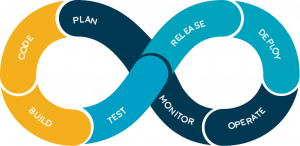For most companies, Digital Transformation is no longer just a buzzword but a very real shift in how every aspect of the organization operates. That is certainly true for IT and one of the somewhat ironic characteristics of this shift is a huge emphasis on automation. Ironic, because you would have thought that Information “Technology” was always about automation, which is pretty much a synonym for computing. Well, better late than never, I guess.
One of the results of this renewed focus on automation is increased scrutiny of tooling, a desire to understand the similarities and differences of the vast array of available tools and which tool is best for which function.
I’m choosing proxies for these two categories; Control-M, the product I work for and the leading1 application workflow orchestration tool and Jenkins, the most popular Continuous Integration (CI) tool.
Control-M according to
Control-M
The home page states “Control-M simplifies application workflow orchestration, making it easy to define, schedule, manage and monitor application workflows, ensuring visibility and reliability, and improving SLAs.” The primary Control-M focus is operating business applications in production.
Jenkins
From jenkins.io the subhead on the site is very instructive and captures the essence of the comparison here; it states “Build great things at any scale”. The emphasis is on building software. The Press page stresses the focus on building software with this “blurb” : “Jenkins is … supported by … people interested in continuous integration, continuous delivery and modern software delivery practices. Built on the Java Virtual Machine (JVM), it provides more than 1,500 plugins that extend Jenkins to automate with practically any technology software delivery teams use. … ”
Hear from Users
When evaluating tools, user experience can be helpful and both web sites contain several testimonials. Here are a few selections.
Jenkins
T-Mobile: “We … support their internal and external customers by adopting robust and intelligent practices that speed up the CI/CD cycle.”
“The real magic happens when our developer teams take ownership of the simplified CI/CD pipelines.”
1 Enterprise Management Associates (EMA) Radar Report for Workload Automation
Morningstar: “Morningstar practices continuous integration (CI) with the … Jenkins Platform to improve consistency and increase automation—vital steps along the organization’s path to continuous delivery (CD) and a DevOps culture. “
Control-M
Hershey’s: Todd Lightner from the Hershey Company describes in this blog how Hershey’s is using Control-M to help keep inventory stocked at stores. Included below is his description of their use case:
“The data center operations group runs thousands of jobs each day. These jobs manage the digital interactions that are necessary to run our business—not just manufacturing, supply planning, supply chain, warehousing, and distribution but also finance, payroll, costing, human resources, marketing, and sales. We handle many of these functions within our complex SAP® environment. BMC’s Control-M solution automates most of these jobs and processes. … So, when anyone asks me what Control-M does at The Hershey Company, I tell them that it literally runs our business.”
A case study of Raymond James Financial on BMC’s website describes their use:
“Control-M manages jobs across complex interdependencies among hundreds of applications that access the company’s data warehouse and consolidated data store. Nightly processing ensures that senior management and financial advisors have the data they need to help clients with investment decisions.”
And Analysts
Analyst coverage of Jenkins has been sparse, possibly due to its independent Open-Source status. However, some documents include this IDC Innovators report and Control-M has historically been covered under the Workload Automation category by Gartner and EMA. The most recent report on Workload Automation is an EMA Radar report that can be found on the BMC’s website.
So, What IS the Difference?

Once an application reaches the Operate and/or Monitor phases, frequently referred to as “production”, application workflow orchestration provides visualization and management of the processes that execute key business services like customer billing, inventory management, training of recommendation and maintenance models and business analytics.
When choosing between these tool categories, identify what you need to automate, who will create and then operate the automation and what impact there may be to your organization as a result of those choices.
These postings are my own and do not necessarily represent BMC's position, strategies, or opinion.
See an error or have a suggestion? Please let us know by emailing blogs@bmc.com.






